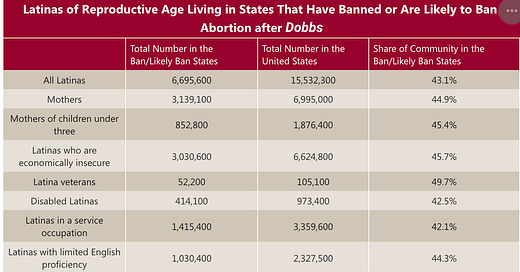New study shows effect of abortion laws on Latinas
Nearly 6.7 million Latinas – 43 percent of all Latinas ages 15-49 – live in the 26 states that have banned or are likely to ban abortion.
More than 40 percent of all Latinas living in the United States between the ages of 15 and 49 reside in abortion-restrictive states.
They represent the largest group of minority women to be affected by those bans, according to a new report by the National Partnership for Women and Families and the National Latina Institute for Reproductive Justice. Other key findings from the study include:
Nearly 6.7 million Latinas – 43 percent of all Latinas ages 15-49 – live in the 26 states that have banned or are likely to ban abortion. They represent the largest group of women of color impacted by current or likely state bans.
Nearly half of all Latinas who live in these 26 states are already mothers,
This analysis defines “mother” as having at least one child (including step, adopted, or biological) under 18 in the household. Due to data limitations, some mothers are not included in this definition, including those who have non-resident or older children or those whose children have passed away.
Nearly half of all Latinas who live in these 26 states are already mothers including 852,800 mothers of children under three. Research shows that when mothers cannot access abortion care, their existing children's economic security and development are negatively impacted.
More than 3 million Latinas living in these states are economically insecure.
State bans significantly impact women with low incomes as they are more likely to lack access to the necessary funds to travel to another state for abortion care. Furthermore, women who are denied abortion care are significantly more likely to be pushed deeper into poverty as a result.
Close to half of all Latina veterans in the U.S. live in states that have or are very likely to ban abortion after Dobbs. While the U.S. Departments of Veterans Affairs (VA) has acted to expand access to abortion care, not all veterans are eligible for or utilize VA health care.
Nearly 43 percent of disabled Latinas live in these 26 states. Disabled people already face barriers and discrimination in accessing health and abortion care, but disabled people of color face additional and unique barriers based on the intersection of their identities. These barriers are worsened by stereotypes and stigma regarding the sexuality of people with disabilities. Dobbs has compounded these problems by adding additional costs and accessibility barriers to accessing care.
More than 1 million Latinas who live in states that have or are likely to ban abortions report not speaking English at all or not speaking it well.
Among respondents who report not speaking English or not speaking it well, the vast majority (more than 99 percent) speak Spanish; less than one percent speak Portuguese or a Native language.
This language barrier substantially challenges accessing and receiving culturally competent abortion care.




